Israel’s proxy war against BRICS
Israel is not only seeking to establish Greater Israel, but is also implementing the overall strategy of Anglo-Saxon world domination: the destruction of BRICS and the prevention of Eurasian integration.
Andreas Mylaeus
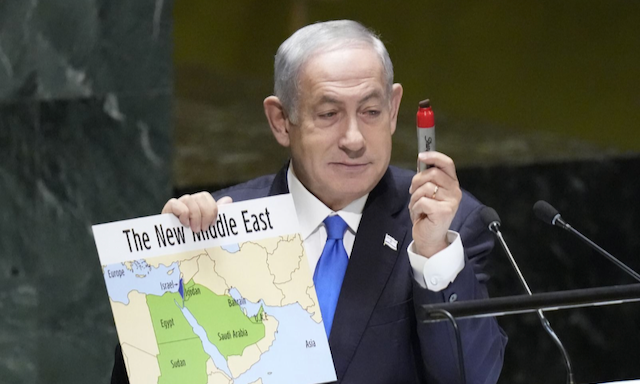
Introduction
This war is the implementation and continuation of a decades-long strategy of the West against Iran, the realization of which follows a script that can be traced in numerous documents from authoritative American think tanks.
Nevertheless, this war is widely reported as if it were the activity of a single madman, albeit with Western support. Israel’s Prime Minister Netanyahu has started a new war in the Middle East by attacking Iran while it was negotiating with the US over its nuclear program. It is time to stop Netanyahu, according to Anti-Spiegel under the headline “Who will finally stop the madman?”
Other renowned observers of world affairs, such as M. K. Bhadrakumar, also assume that Donald Trump is interested in a “constructive rapprochement” with Iran and sees himself hindered by Netanyahu.
Even the German Chancellor talks about “Israel doing the dirty work for us” and the German press cheers him for it.
In this article, we show that this war was not launched by Israel against the “peaceful intentions” of the US or even against its will, but that it fits seamlessly into the strategy of Anglo-Saxon policy towards Iran since 1953. We consult experts and have analyzed strategy studies by American think tanks for you.
The current pretexts for the war against Iran: old hat
Preemptive attack
The version propagated by the West is that Israel is preemptively exercising its right to self-defense with this attack because a nuclear-armed Iran would call Israel’s right to exist into question.
However, under international law, such pre-emptive self-defense is only permissible as a countermeasure in the event of an imminent attack if the threat is clear, concrete and immediate (“caroline case” criterion: “instant, overwhelming, and leaving no choice of means, and no moment for deliberation”).
If these conditions are not met, this is a violation of the prohibition of the use of force under international law (Article 2(4) of the UN Charter).
Alleged violation of nuclear regulatory rules as a lame excuse
The narrative the West is relying on is as follows:
A report by the International Atomic Energy Agency (IAEA), which was sent to member states on Saturday, June 14, 2025, states that Iran’s stockpile of uranium enriched up to 60 percent has increased by about half to 408.6 kg. According to IAEA estimates, this amount of uranium, if enriched to 90 percent, would be sufficient for nine nuclear weapons.
A second report claims that Iran conducted clandestine nuclear activities decades ago at three sites with material that had not been reported to the UN nuclear watchdog.
Citing the findings of these reports, the Western powers, with their majority, passed a resolution at the IAEA meeting on June 12, 2025, officially reprimanding Iran for violating its safeguards obligations. The result of the vote was as follows: 19 votes in favor of the Western resolution, 3 votes against (Russia, China and Burkina Faso), 11 abstentions, 2 members did not attend or did not vote.
The IAEA is a Western-dominated institution with strongly ideological structures. There is no evidence that Iran has actually violated IAEA rules.
But even if these alleged violations – some of which, according to the applicants for the resolution, date back years – were confirmed, this would never be enough to justify an imminent threat from Iran to Israel, which would entitle Israel to launch a pre-emptive strike.
Netanyahu – chief hatemonger against Iran for 30 years
On behalf of the West, Netanyahu peddles the thirty-year-old propaganda that Iran wants to wipe out Israel with a nuclear bomb. In the picture, Netanyahu at one of his innumerable appearances, here at the UN General Debate in June 2025:
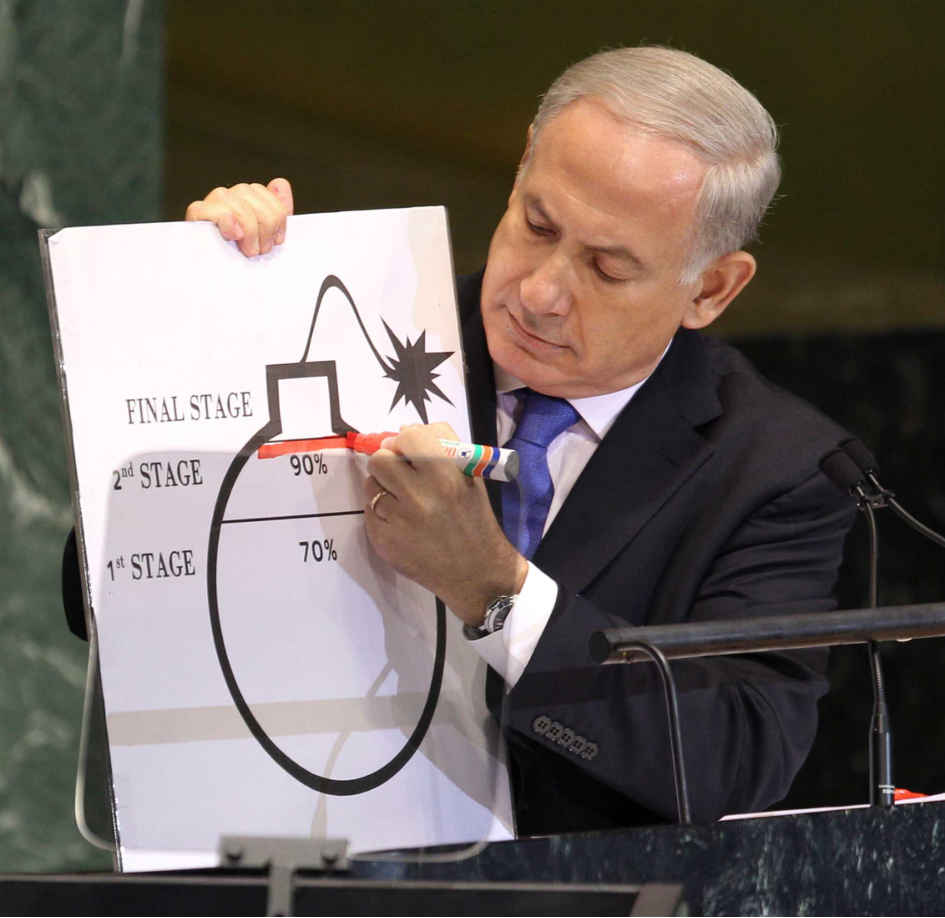
This propaganda drumbeat is old hat. This doomsday scenario has been “imminent” for decades.
Here is the list of repeated claims “Iran is on the verge of a nuclear bomb”
| Year | Claim | Forecast period |
| 1984 | German intelligence: Iran could build a nuclear bomb within 2 years | 1986 |
| 1992 | Israeli MP Benjamin Netanyahu: Iran will have a bomb in 3-5 years | 1995–1997 |
| 1995 | US Secretary of State Warren Christopher: Iran soon with nuclear capability | „Innerhalb von 5 Jahren“ → 2000 |
| 1996 | Israeli Prime Minister Shimon Peres: Iran will have nuclear weapons by 1999 | 1999 |
| 2003 | Israeli military intelligence: Iran could have a bomb by 2005 | 2005 |
| 2006 | US intelligence report (NIE): Iran is 5-10 years away from the bomb | 2011–2016 |
| 2009 | Israeli Prime Minister Netanyahu: Iran is “one to two years away” | 2010–2011 |
| 2010 | US Defense Secretary Robert Gates: Iran could have a bomb by 2011 | 2011 |
| 2012 | Netanyahu at the UN: Iran could build a bomb in 6-12 months | 2013 |
| 2013 | Israeli officials: Iran 1-2 months away from “breakout” | 2013–2014 |
| 2015 | Opponents of the nuclear deal claim Iran is 2-3 months away from the bomb | 2015–2016 |
| 2018 | After the US withdrew from the nuclear agreement: Israel warns again that Iran will be ready within a year | 2019 |
| 2021 | US officials: Iran’s “breakout” time down to 2-3 months | 2021 |
| 2023 | IAEA: Iran hat genug Uran für „mehrere Bomben“, wenn es weiter angereichert wird | Implizit: <1 Jahr |
Iran does not have a bomb and is not building one
Here is an excerpt from the official transcript of Tulsi Gabbard’s (Director of National Intelligence – DNI) testimonybefore the Senate Select Committee on Intelligence, held on March 25, 2025 as part of the Annual Threat Assessment of the U.S. Intelligence Community:
“The Intelligence Community continues to assess that Iran is not building a nuclear weapon and Supreme Leader Khamenei has not authorized the nuclear weapons program that he suspended in 2003. We continue to monitor closely if Tehran decides to reauthorize its nuclear weapons program.“
Tulsi Gabbard – 25. März 2025
The US Intelligence Community is an association of 18 separate government organizations that conduct both independent and joint intelligence activities in support of the national security of the United States. Tulsi Gabbard heads this agency.
That was a clear statement made under oath by the person (Tulsi Gabbard) on whom the American president must rely when making his decision. There can therefore be no question of a clear, concrete and immediate threat.
As before the Iraq war in 2003 – history repeats itself
This tactic was also used in 2002/2003 to create a justification for the attack on Iraq, which the US claimed had weapons of mass destruction.
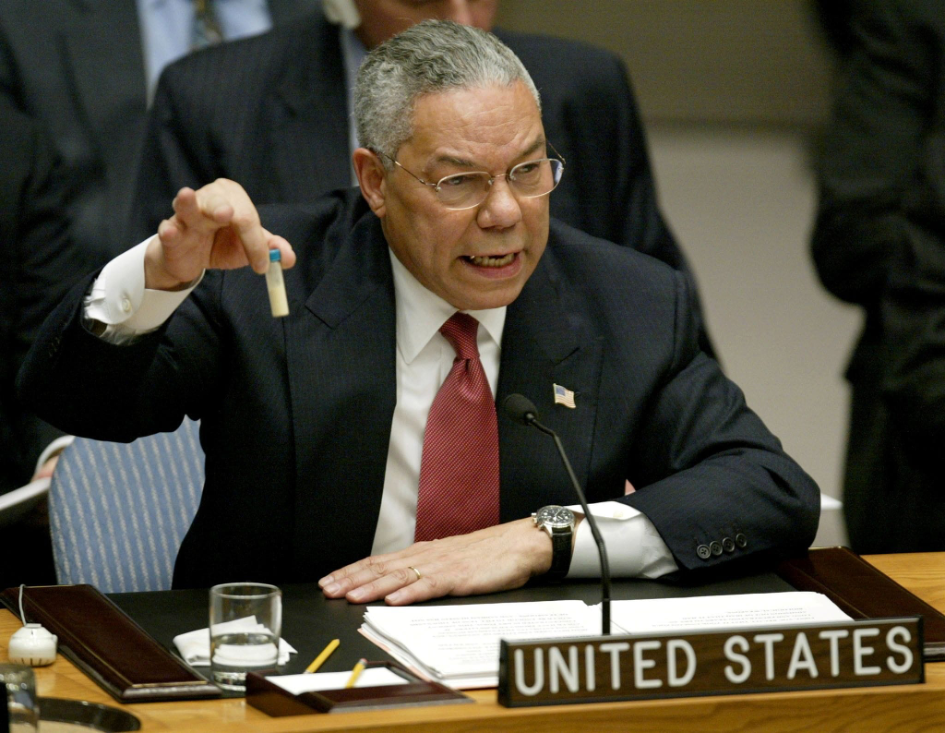
Today we know this was a lie, but the propaganda was effective in gaining support in the US and Europe for the invasion of Iraq. Today we are seeing similar efforts, only this time Iran is being falsely accused of enriching uranium to build a bomb. The lie about weapons of mass destruction in Iraq, just like the current smears against Iran, has only one purpose: to justify military action to achieve regime change.
If anyone should be forced into nuclear disarmament, it would be Israel
This Armageddon propaganda described above cannot be surpassed in its mendacity and double standards. If the aim were really to make the West Asian region free of nuclear weapons – in which the Iranians in particular have a vital interest – one would start with Israel. Although Israel has never officially admitted to possessing nuclear weapons, it has pursued a policy of “nuclear ambiguity” for decades, i.e. it neither confirms nor denies that it has nuclear weapons. Nevertheless, experts assume that Israel has had a considerable nuclear arsenal since the 1960s (estimated at 80-90 warheads). If you want to delve deeper into this topic, we recommend these books: Seymour Hersh – “The Samson Option: Israel’s Nuclear Arsenal and American Foreign Policy” (1991); Avner Cohen – “Israel and the Bomb” (1998); this is probably the most important and in-depth scholarly overview of Israel’s nuclear weapons program. It documents the development of the program, the policy of “nuclear opacity” and situations such as 1973, in which nuclear readiness was established. Cohen describes a “nuclear alert” during the Yom Kippur War, which is to be understood as a deterrent against the Soviet Union and as a signal to the US.
The fact that the West is not even considering forcing Israel to disarm shows that this argument is a sham against a country such as Iran, which, according to the unanimous statement of all US public services, does not have or does not want to build nuclear weapons or can build them in the short term.
Has Netanyahu actually sabotaged a constructive US rapprochement with Iran with his attack on Iran?
US negotiations with Iran – a pure mafia charade
As mentioned above, many are falling for the American propaganda fairy tale that Netanyahu’s Israel, with its attack on Iran, was trying to sabotage the “constructive rapprochement” with Iran initiated by the Trump administration and that the US had honestly tried to solve the aforementioned problems of Iran’s nuclear armament through negotiations before the attack on Iran.
However, there can hardly be any talk of “negotiations” here. Original quote from Donald Trump:

That was on June 13 and here is the full text of Donald Trump’s Truth Social post on June 17, 2025:
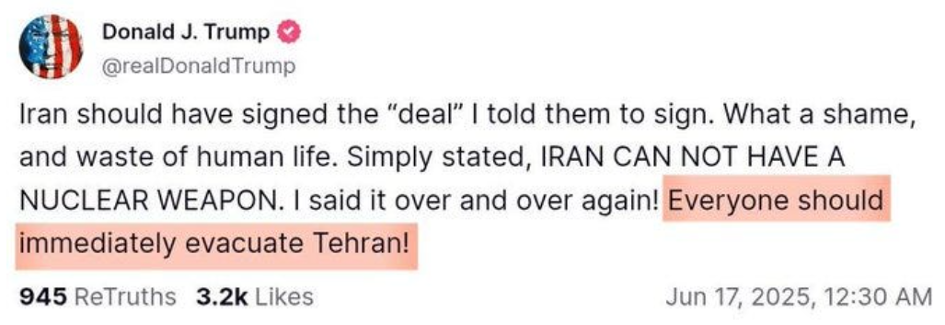
Prof. Jeffrey Sachs commented on this type of “negotiation” with Judge Napolitano on June 13, 2025 as follows:
“There is no diplomacy in our world today. There is only war and violence, and I find that extremely depressing to be honest. The US reaction, Trump’s reaction makes it clear that this was a joint action by Israel and the US. Trump says: ‘Look, Israel can destroy you. It will kill you all. You have to agree with me. That’s called US-style negotiation. That’s a kind of fascism. That’s what it is. It means we’ll kill you if you don’t agree with our point of view.”
Jeffrey Sachs – 13. Juni 2025
The mafia-style negotiations and the constant back and forth between different exponents of the Trump administration with contradictory statements about what needed to be achieved in the negotiations ultimately only served to distract Iran from the already planned date of the start of the war. Apparently, this was at least partially successful.
Confirmed “participation” of the US in the war
US Secretary of State) Marco Rubio claimed on June 12-13, 2025 that Israel had carried out the attacks on Iran unilaterally – i.e. without the direct involvement of the US.
“We are not involved in attacks against Iran, and our top priority is to protect American forces in the region.”
Marco Rubio – 12. Juni 2025
He also explicitly warned that Iran should not target US interests or individuals.
The truth is as follows: According to a June 13, 2025 ABC News report, Trump and Netanyahu spoke by phone on Friday 6/13-25. The previous day, Israel had bombed “Iran’s nuclear facilities” with dozens of strikes.
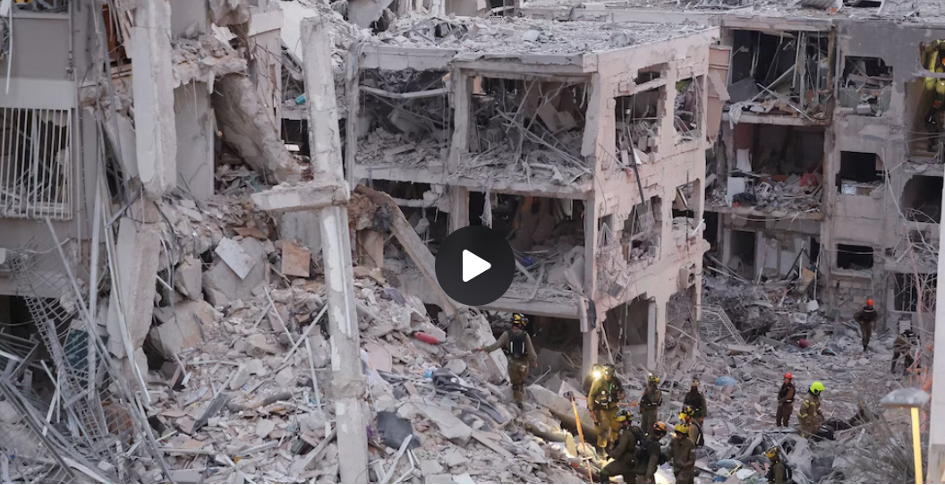
Donald Trump said the following to the ABC News reporter on June 13: “I think it was excellent. We gave them a chance, and they didn’t take it. They were hit hard, very hard. They got hit as hard as you can get hit. And there’s more to come, much more.”
The geopolitical significance of Iran as the key to Eurasia
Mackinder and Brzezinski
The fact that Israel’s proxy war against Iran is also a war against the power shifts in Eurasia, which the “only world power” (Brzezinski) is fighting against, is already evident in the well-known Anglo-Saxon geopolitical interests.
Back in the days of the British Empire, Halford John Mackinder, a British geographer, politician and geostrategist, shaped the strategic thinking of major world powers with his famous “Heartland Theory” in 1904 – and continues to do so today. His basic idea was: “Whoever controls the Heartland controls the world island (Eurasia), and whoever controls Eurasia controls the world.” Iran is located on the southern edge of the Heartland region, or more precisely: on the “Inner Crescent”, i.e. the peripheral belt around the Heartland. It is a buffer state between Russia (Heartland) and the Indian Ocean. Access to the “world island” of Eurasia was then crucial: whoever controlled Iran could block or enable Russian access to the Persian Gulf or the Indian Ocean.
This tradition of thought was later continued by Zbigniew Brzezinski in particular. In his seminal work “The Grand Chessboard: American Primacy and Its Geostrategic Imperatives” (1997), he describes Eurasia as the center of world power. The US would have to retain control of the key regions in order to secure its global supremacy. Brzezinski defines Iran as part of the “geostrategic arc” from the Middle East to Central Asia. Iran is a geopolitical pivot because it lies at the interface between the Caspian region (raw materials), the Middle East (energy and Islamism) and South and Central Asia (post-Soviet space). It could serve either as a bridgehead or as an obstacle to US influence.
Strategy papers from leading American think tanks
This way of thinking and the proposals for corresponding instructions (scripts) are also reflected in the strategy papers of leading American think tanks. Here are the three most important: “A Clean Break: A New Strategy for Securing the Realm” from 1996; “Rebuilding America’s Defenses: Strategy, Forces and Resources for a New Century” from 2000; WHICH PATH TO PERSIA? Options for a New American Strategy toward Iran from 2009.
The first two neoconservative strategy papers (“A Clean Break” and “Rebuilding America’s Defenses”) had an ideological impact on many actors in the Bush administration and beyond. Their impact can be seen in the US interventions in Afghanistan (2001), Iraq (2003), Libya (2011) and Syria (from 2011 and now 2025), among others.
The third strategy paper “WHICH PATH TO PERSIA?” shows the alternatives discussed in 2009 for the current actions of the US and Israel and their roles in the current war against Iran. It clearly shows the handwriting and dominance of the US over current events, in which “Bibi” is clearly assigned an executive role.
A Clean Break: A New Strategy for Securing the Realm
This paper from July 1996 was written for the Israeli government – in particular for Prime Minister Benjamin Netanyahu, who had just been elected Prime Minister of Israel in his first election. It outlines a new foreign and security policy strategy for Israel. The authors were a group of neoconservative US strategists led by Richard Perle, including Douglas Feith, David Wurmser and Meyrav Wurmser from the Institute for Advanced Strategic and Political Studies (IASPS) in Jerusalem and Washington D.C.
The aim and thrust of the paper was a radical break (“clean break”) with previous Israeli security strategies. Instead of relying on compromises with the Palestinians or Arab neighbors (e.g. the Oslo peace process), it calls for a departure from the previous land-for-peace policy. The Oslo Accords are seen as a strategic mistake. Israel should no longer make any territorial concessions. There must be a “new strategic environment”. Iraq, Syria and Hezbollah are presented as the main threats. The aim is a geopolitical shift in the region in Israel’s favor.
The authors call for Israel to be less dependent on the US when it comes to policy-making and for an offensive security policy and pre-emptive strikes. Israel’s enemies must be destroyed by destabilizing their regimes. A “regime change” in Iraq is explicitly mentioned. Syria should be weakened through pressure and isolation.
The authors belonged to the neoconservative movement in the US. Many were later members of the Bush administration (2001-2009) or its entourage and supporters of the 2003 Iraq War.
Rebuilding America’s Defenses: Strategy, Forces and Resources for a New Century
This document, published in September 2000 by the Project for the New American Century (PNAC), is a key text of neoconservative US foreign and security policy shortly before the presidency of George W. Bush. It was edited by Thomas Donnelly (author), with the participation of neoconservatives such as Paul Wolfowitz, Donald Kagan and others.
The paper outlines a strategy to secure the US’s global dominance in the 21st century – through military, technological and political superiority. The central objective was: “Establishing a Pax Americana” – an “American peace order” based on unchallenged military strength.
In order to secure the global dominance of the US, any competition that could gain regional or even global power was to be prevented, even pre-emptively. This required a strong military presence in strategic regions (Eurasia, the Gulf region, East Asia). This resulted in the explicit demand for the expansion of military bases worldwide.
In order to eliminate competition for power, the promotion of regime change and a forward strategy are proposed. Iraq (Saddam Hussein is to be removed from power) and Iran are mentioned several times as targets.
In order to achieve these goals, a military build-up, massive investments in new technologies such as missile defense, cyberwarfare, space armament and an overall quadrupling of investments in “future war” are required. The US armed forces would have to be restructured, moving away from a “defense army” to a projectionist intervention army that can strike quickly and globally at any time in order to transform opponents through a “catalytic shock”.
One of the most quoted passages from this paper reads like a premonition of the events of 9/11:
“…the process of transformation is likely to be a long one, absent some catastrophic and catalyzing event – like a new Pearl Harbor.”
Many PNAC authors became influential members of the Bush administration from 2001 onwards, who actively implemented the strategies and goals outlined in this paper (Paul Wolfowitz became Deputy Secretary of Defense, Donald Rumsfeld became US Secretary of Defense, Richard Perle became Pentagon Advisor and Dick Cheney became US Vice President.
The fact that this paper was not a purely theoretical treatise is shown by the fact that it was followed exactly. In an interview with Democracy Now! (2007), former NATO commander-in-chief General Wesley Clark reported that shortly after the attacks of September 11, 2001, a Pentagon employee showed him an internal plan that stated:
“We will attack seven countries in five years – starting with Iraq, then Syria, Lebanon, Libya, Somalia, Sudan and finally Iran.”
Source: Democracy Now!, March 2, 2007
(Also quoted in his book by Wesley Clark “A Time to Lead”)
It is well known that this plan has been implemented step by step (Afghanistan 2001, Iraq 2003, Libya 2011 and Syria from 2011 and now 2025) – and now it is finally Iran’s turn.
It is also important to remember that Mackinder’s “world island” and Brzezinski’s “Eurasia as the center of world power” were preparing to become independent and elude the grasp of the “single world power” almost parallel to these war events. The first official contact between the first four countries – Brazil, Russia, India and China – took place in 2006 on the fringes of a UN General Assembly. The first BRIC foreign ministers’ meeting took place in 2008, and the first BRIC summit was held in Ekaterinburg (Russia) on June 16, 2009, marking the beginning of the political alliance. South Africa was admitted in 2010 and since then it has been called BRICS. Initially, the hegemon did not take this loose association seriously. In the meantime, however, the fight against it has fully flared up, because this was exactly what Macinder and Brzezinski, and after them the aforementioned strategy papers, warned against: A power shift, consolidation and integration of Eurasia.
Iran has therefore always been the “keystone”, so to speak, in the archway to world domination. This gate urgently needed to be closed. Various strategies were therefore considered as to how this goal could be approached. The result of these considerations can be seen in the strategy paper below.
WHICH PATH TO PERSIA? Options for a New American Strategy toward Iran
ANALYSIS PAPER Number 20, June 2009
This document follows on seamlessly from the aforementioned documents and the geopolitical theorists mentioned. Anyone who thinks that an “insane” Netanyahu is pushing the US into a war against Iran against its actual will and against its interests should take a look at this strategic planning and analysis by the Brookings Institution from 2009. It presents various categories with corresponding specific options, which are not mutually exclusive but complementary:
First, one tries diplomacy (although the methods don’t actually match the word). One speaks of persuasion and means economic pressure, coupled with a limited diplomatic offer or engagement and pretends to mean an active dialog, such as a new nuclear deal.
But because we know that we can hardly make any progress in this way, we are analyzing military options such as a US invasion(“going all the way”) with ground troops (boots on the ground). However, a full military invasion of Iran by the US has considerable disadvantages (loss of soldiers and material) and costs. Air strikes (“Osiraq option”), i.e. targeted attacks on Iran’s nuclear or military facilities by the US Air Force, have slightly fewer disadvantages. According to these considerations, however, the most advantageous method would be for Israel to carry out the military option alone. In the paper, this is called “Leave it to Bibi”. The US encourages Israel to strike itself – US support is possible, but without direct involvement – and always with the option of distancing itself from the action for PR reasons if necessary.
The goal of the aforementioned options is regime change in Iran. Attempts are being made to instigate a popular uprising (“velvet revolution”) with the support of internal protest movements. Help for opposition groups/minorities should be used: “Inspiring an insurgency ‘ through to support for a military coup against the regime (’the coup”).
A last resort, if all else fails, would be the containment option. This would preserve the status quo and keep Iran in check. However, the US would not actively attack Iran itself.
The authors emphasize that none of these options is unproblematic – each carries high risks and possible side effects; the smartest strategy could be a combination of approaches.
Central to the US, however, remains the need to minimize the PR downsides of direct US involvement in the war. The paper therefore emphasizes that the best way to minimize international criticism and maximize US support in the war (albeit “reluctantly” or covertly) would be to strike only when there was a widespread belief that the Iranians had been made an excellent offer but had rejected it – an offer so good that only a regime determined to acquire nuclear weapons would turn it down. Under these circumstances, the United States (or Israel) could portray their operations as regrettable, not aggressive. One assumes that at least part of the international community would then conclude that the Iranians brought this on themselves by refusing a very good deal.
Lo and behold, Donald Trump is trying exactly this strategy.
The other strategic proposals have also been partially implemented. Israel flies targeted air strikes far into Iran – on nuclear and military facilities. This corresponds exactly to the Osiraq strategy. The US has encouraged Israel and sent it forward as a proxy (“Leave It to Bibi”). The US provides air refueling, transmits intelligence and positions troops – without officially waging open war. This corresponds exactly to the model in which Israel acts in the foreground, but the US provides support in the background.
An invasion with US troops does not appear to be planned (although there are loud voices in the US Congress calling for exactly that). But Donald Trump reserves the right to officially make the US a party to the war if necessary.
A coup against the Iranian leadership was indeed intended, but has not been achieved and is ruled out according to the information available.
What has the West achieved so far in this war?
The hoped-for “popular uprising” against Iran’s political leadership, the planned transformation through a “catalytic shock” (see above in the paper “Rebuilding America’s Defenses”) has failed to materialize. The opposite has happened: The majority of the population is rallying around the flag and supporting self-defense against Israel and the US.
The planned “decapitation strike” against the Iranian military and political leadership was not successful.
Yes, a number of military leaders were killed who were together in a bunker where they had held a joint exercise. Yes, Iran was shocked – also because the cyber attack by the Mossad (with the help of the cooperating secret services of Western countries) on the air defenses was temporarily successful. But these problems were solved in no time at all – with the active help of Russian IT specialists, by the way.
The betrayal of the US in the fake negotiations with Iran over the issue of nuclear enrichment has rendered Western “diplomacy” absolutely untrustworthy. Not only the BRICS partners Russia and China, but the entire Collective West and Asia have been shown once and for all what the West’s “fine words” are worth. This has already led to Pakistan and China, for example, supplying weapons to Iran. Russia and China have made it clear that the destruction of Iran will not be tolerated. Both countries have unequivocally condemned the attack on Iran in the UN and described it as contrary to international law. The words and attitude of the diplomats concerned were much more sustained and determined than before.
Iran has abandoned its previous restrained, de-escalating stance towards the provocations of Israel and the US and now sees itself completely in a state of war. Similar to Russia in Ukraine, its aim will be to completely disarm the proxy of the West if no negotiated solution can be reached. Temporary ceasefire negotiations are likely to be out of the question. Iran is waging a war of self-defense to preserve its existence – no ifs, ands or buts.
Israel’s energy supply and essential military facilities have obviously been badly hit, and its air defenses against Iranian missiles are largely useless. The water supply to major cities such as Haifa and Tel Aviv is defenseless against enemy missiles. However, Iran is currently sparing the Israeli civilian population and is only attacking strategic military targets. Because Israel enforces a complete news blackout on the damage suffered, much remains hidden in the fog of war. But things are not looking good for Israel.
Concluding remarks
All in all, it looks as if the West as a whole is currently still determined to fight “to the last Israeli” – as was the case with Ukraine – in order to cause as many problems as possible for the hated systemic competitor BRICS and thus delay its own demise if possible. Whether the US will actually officially act as a belligerent depends not least on the decisive reaction of Russia and China and their partners.
27 thoughts on “Israel’s proxy war against BRICS”